When Motorcycle USA set out to modify our long-term 2011 Kawasaki Z1000 project, we decided to take it in a direction that most wouldn’t. After having a good time with it during the 2011 Streetfighter Shootout, we decided to coax a bit more racetrack performance out of the Green Machine. In the first installment, 2011 Kawasaki Z1000 Project Part 1, LeoVince dialed the Z in with an EVO Factory-R Slip-on Exhaust and a Fast II Tuning box to complement the first phase of putting the big lump on a diet. With a modest but noticeable result, what else could we do but take it further?
In the Shop
In the Shop

With a new set of Renthal FatBar handlebars the front end feel of the Kawasaki Z1000 has improved.

One of my complaints with the stock handlebars on the Z1000 is that the tall bend was a stretch at full lean. While my body was near the pavement the bars, either my left or right hand was in another area code. Searching for a suitable street bars netted no viable options, and we considered affixing a set of clip-ons as a last resort. Then I spied a set of Renthal FatBars ($89.99) meant for our 2012 KX250F. With an inch hacked off the ends the bars fit perfect and were more than an inch lower. Now that may not seem like a big difference, but that combined with less of a sweep meant a more aggressive and forward position. Another benefit of ditching the stock bars was a loss of five pounds.
Ditching the heavy bars got us looking for more places to cut weight. The horn was removed, the kickstand ditched and all the reflectors and mounting hardware tossed in the pile of discarded Z1000 parts. That accounted for another five pounds.
After swapping the bars we contacted Rizoma to get our mitts on some high-quality controls. A few days later a box arrived containing the Italian Company’s Sport Line Grips, Feel Levers, and ProGuard system. Each piece was packaged carefully in a box with foam holding each piece of finely crafted aluminum. Bolting everything up was straightforward and quick.
The Feel levers have a nice bend and the CNC machining on the leading edge provides and bit of traction on gloved fingers. A channel cut into the end of the lever is meant to channel and remove air pressure on the flat edge that rises dramatically at high speeds. A gold anodized knob makes adjusting the reach to the lever a snap.
Rizoma’s ProGuard System is designed to prevent inadvertent actuation if the clutch or brake levers contact with other racer’ machines or bodies on the track. An aluminum stalk comes out of the end of the bar and wraps around the end of the lever where the mechanical force is the greatest. Mounting the ProGuard lever guards took a bit of trial and error
Ditching the heavy bars got us looking for more places to cut weight. The horn was removed, the kickstand ditched and all the reflectors and mounting hardware tossed in the pile of discarded Z1000 parts. That accounted for another five pounds.
After swapping the bars we contacted Rizoma to get our mitts on some high-quality controls. A few days later a box arrived containing the Italian Company’s Sport Line Grips, Feel Levers, and ProGuard system. Each piece was packaged carefully in a box with foam holding each piece of finely crafted aluminum. Bolting everything up was straightforward and quick.
The Feel levers have a nice bend and the CNC machining on the leading edge provides and bit of traction on gloved fingers. A channel cut into the end of the lever is meant to channel and remove air pressure on the flat edge that rises dramatically at high speeds. A gold anodized knob makes adjusting the reach to the lever a snap.
Rizoma’s ProGuard System is designed to prevent inadvertent actuation if the clutch or brake levers contact with other racer’ machines or bodies on the track. An aluminum stalk comes out of the end of the bar and wraps around the end of the lever where the mechanical force is the greatest. Mounting the ProGuard lever guards took a bit of trial and error

Rizoma's ProGuard System protects levers from accidental actuation by other riders.
to get the spacing correct, but within 30 minutes we had everything mounted up.
The Sport Line grips are aluminum tubes with rubber where the hand would rest. We were a bit worried about the aluminum being too to large and smooth near the inside of the grip, but decided to save judgment until on the track.
Next on the list of goodies was a Vortex 525 CAT5 Rear Sprocket ($74.95) and Vortex 525 Front Countershaft sprocket ($24.95). We decided to go one tooth larger on the rear sprocket to gain a little more punch out of the corners. The black anodized rear sprocket is lighter and much better looking than the heavy steel unit that once resided on the rear wheel. While we were at it we fitted a new gold RK 525 XW-Ring Chain ($246.95). Vortex was also good enough to supply us with a set of Swing Arm Spools since we tossed the kickstand in our quest for lightness.
Finally we fitted a $129 Kawasaki Genuine Accessories Tall Windshield to tuck under at speed and a Kawasaki Genuine Accessories Seat Cowl ($199). Both bolted up in less than five minutes and added function and style to our beloved Z.
The Sport Line grips are aluminum tubes with rubber where the hand would rest. We were a bit worried about the aluminum being too to large and smooth near the inside of the grip, but decided to save judgment until on the track.
Next on the list of goodies was a Vortex 525 CAT5 Rear Sprocket ($74.95) and Vortex 525 Front Countershaft sprocket ($24.95). We decided to go one tooth larger on the rear sprocket to gain a little more punch out of the corners. The black anodized rear sprocket is lighter and much better looking than the heavy steel unit that once resided on the rear wheel. While we were at it we fitted a new gold RK 525 XW-Ring Chain ($246.95). Vortex was also good enough to supply us with a set of Swing Arm Spools since we tossed the kickstand in our quest for lightness.
Finally we fitted a $129 Kawasaki Genuine Accessories Tall Windshield to tuck under at speed and a Kawasaki Genuine Accessories Seat Cowl ($199). Both bolted up in less than five minutes and added function and style to our beloved Z.

New Vortex Sprockets and a gold RK chain put the power to the rear wheel.
After it was all said and done, our time in the shop netted us an additional 11 pounds of lost weight, to a total of 462 pounds. That’s 21 from stock trim. We contemplated ditching the headlight, taillight and blinkers to see where the Z1000 would end up on the scales, but the effort involved was too great and finding a front fairing would be nearly impossible.
On the Track
To test the mettle of the newest additions we joined Let’s Ride Track Days at Buttonwillow Raceway for Saturday and Sunday riding sessions. Buttonwillow’s track surface is not as pristine as some of the other facilities in California, but the tight and bumpy layout would be an excellent to see how the Z1000 would handle with the new handlebars and gearing.
Right off the bat you could feel the 11 pounds that were removed. Flicking from side to side was quicker and took a touch less effort than the previous outing for the 2011 Kawasaki Z1000 Project Part 1. It’s still no Speed Triple R, but the improvement is nothing to scoff at.
The new Renthal bars really made a difference in how the Z1 is ridden. Before the seating position was fairly upright even when on its side because of the tall handlebars. Now the riding stance is more forward when in a straight line, and you can get close to the tank during turns. This helps with front end feel when pushing through the fast corners, and also is less tiring as you are not fighting the wind as much.
On the Track
To test the mettle of the newest additions we joined Let’s Ride Track Days at Buttonwillow Raceway for Saturday and Sunday riding sessions. Buttonwillow’s track surface is not as pristine as some of the other facilities in California, but the tight and bumpy layout would be an excellent to see how the Z1000 would handle with the new handlebars and gearing.
Right off the bat you could feel the 11 pounds that were removed. Flicking from side to side was quicker and took a touch less effort than the previous outing for the 2011 Kawasaki Z1000 Project Part 1. It’s still no Speed Triple R, but the improvement is nothing to scoff at.
The new Renthal bars really made a difference in how the Z1 is ridden. Before the seating position was fairly upright even when on its side because of the tall handlebars. Now the riding stance is more forward when in a straight line, and you can get close to the tank during turns. This helps with front end feel when pushing through the fast corners, and also is less tiring as you are not fighting the wind as much.

A Kawasaki Genuine Accessories tall windscreen made it easier to tuck behind while blasting down the straights.

As we had suspected the aluminum surface of the Rizoma Sport Line grips was a bit slick if you tend to use the webbing between your thumb and index finger to grip the bars. We either had to choke down on the grip or alter the way we used our hands, and for the track that is not something we would recommend you try to deal with. We would suggest standard rubber units for high performance riding.
While the grips are a bit of a problem, the Feel Levers we excellent. The leverage to the clutch and brakes was solid, and we really like the shape and bend. Thankfully we never had to test the ProGuard System, but it was comforting to know we had our brake and clutch covered.
Adding a tooth to the rear sprocket really helps wake up the Z when coming out of the tighter corners. The revs built quicker down the straights and overall the bike just felt livelier, and of course the wheelies came even easier than before.
It may not seem like adding a few flash parts, changing the bars and re-gearing could make a big difference in the track prowess of a bike like the Z1000, but it really did! All day we had people stopping by to check out the green and black monster and ask questions about how it did on the track. We would always reply, “pretty damn good.”
Stay tuned for Part 3 of our Z1000 Project where we enlist the help of Catalyst Reaction suspension tuning and spoon on a set of Pirelli Supercorsa SP tires.
While the grips are a bit of a problem, the Feel Levers we excellent. The leverage to the clutch and brakes was solid, and we really like the shape and bend. Thankfully we never had to test the ProGuard System, but it was comforting to know we had our brake and clutch covered.
Adding a tooth to the rear sprocket really helps wake up the Z when coming out of the tighter corners. The revs built quicker down the straights and overall the bike just felt livelier, and of course the wheelies came even easier than before.
It may not seem like adding a few flash parts, changing the bars and re-gearing could make a big difference in the track prowess of a bike like the Z1000, but it really did! All day we had people stopping by to check out the green and black monster and ask questions about how it did on the track. We would always reply, “pretty damn good.”
Stay tuned for Part 3 of our Z1000 Project where we enlist the help of Catalyst Reaction suspension tuning and spoon on a set of Pirelli Supercorsa SP tires.
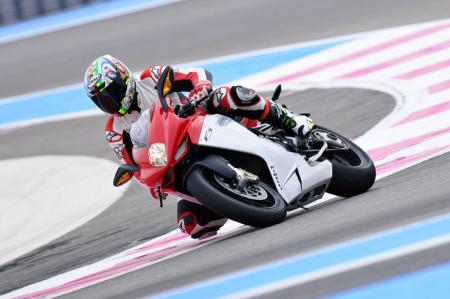 The middleweight supersport class gets an exotic injection with the introduction of the all-new F3 675 from MV Agusta.
The middleweight supersport class gets an exotic injection with the introduction of the all-new F3 675 from MV Agusta.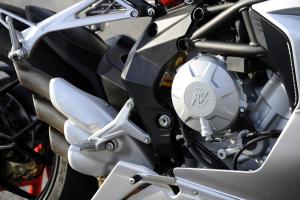 A steel-trellis frame joins aluminum sideplates to cradle the 675cc Triple.
A steel-trellis frame joins aluminum sideplates to cradle the 675cc Triple.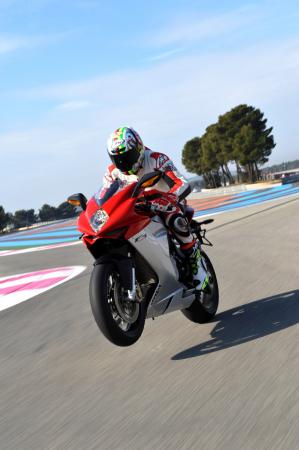
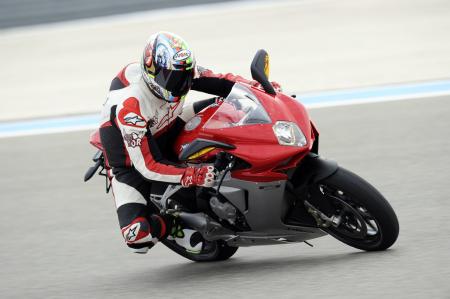 The F3's riding position isn't as uncompromising as its big brother, the F4.
The F3's riding position isn't as uncompromising as its big brother, the F4. 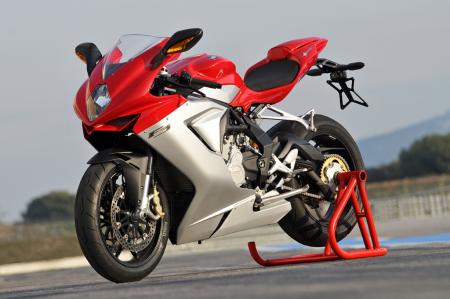 At $13,498, the F3 is relatively affordable, especially for a sportbike from MV Agusta.
At $13,498, the F3 is relatively affordable, especially for a sportbike from MV Agusta.